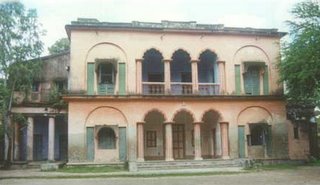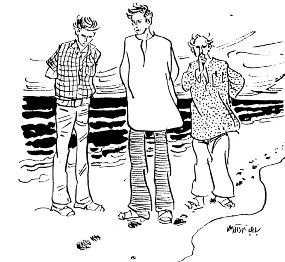
Another day drifted away as we tried in vain to master Meghnadbadh, metamorphic rocks, Mendeleev’s periodic table, Mendel’s genetics, momentum conservation, Muhammad-bin-Tughlaq’s follies, mensuration and the English alphabet.
I always played for the Anandamela team as they were much stronger and it was an intellectual suicide to admit to subscribing to lowbrow Shuktara. Like some other intellectual elites in our school, I did secretly subscribe to Shuktara as well and was once caught red-handed when I was smiling at hNada-bhNoda and bNatul-the-great . The biggest problem, however, arose, during the best period of a Bengali year. Purchasing the Anandamela sharadiya pujabasrhiki (special festive number of a Bengali magazine published during Durga Puja) took care of my hunger for the latest exploits of Professor Shanku , but a certain Mr. Pradosh C. Mitter showed up only on the pages of Sandesh and Desh every alternate year.
One could not just buy the Sandesh pujabarshiki; it was available only to the year-long subscribers. Having never quite taken to the Lila Majumdar-inspired Sandesh genre of Bengali young adult fiction, the yearly subscription was too large a sum of money to spend for one Feluda story. The quality of detection it took to hunt down a Sandesh subscriber and borrow his book before it became available in public libraries was way more impressive than anything Feluda himself had ever displayed.
The years when Feluda graced the pages of Desh, things were even murkier. Unlike Anandamela, Shuktara and Sandesh, Desh was not targeted towards young adults. It is a literary periodical with content not deemed suitable for a boy in his pre-teen or early-teen. A lot of pestering, however, would usually get me a copy from my parents or their friends, but I had to promise to confine my eyes into the Feluda section of the book – the section that immediately followed a few more of Rabindranath’s unpublished letters (always wondered how those letters from a man long dead would magically pop up at the editor’s desk every year). It did not take me long to break the promise though. After gobbling up Feluda’s latest adventure in exactly 85 minutes, with a finger carefully inserted into a page of the Feluda story just in case I needed to go back to the permitted area to avoid suspicion, my gate-crashing into the world of serious and mature fiction began.

Not that Feluda stories were immature or trivial additions to the canon of Bengali literature. They nurtured, educated and entertained a generation: the wit, quirks and individualism of the characters, an infectious child-like curiosity about everything, an empathy for everyone including most of the villains, a vividly visual description of people and places with few precise words, the puzzles, riddles and the wordplays, a Hitchcockian talent to build and sustain suspense and the brilliant illustrations. The influences are more easily noticeable now – Conan Doyle, Sharadindu, Christie, Sukumar Ray (both chromosomal and creative), Woodhouse, Parashuram, Lewis Carroll, American film noir and many others. But what emerged out of these influences was distinctly original and a very interesting mix of Bengali and Western sensibilities and literary traditions.
No discussion of Feluda stories can be complete without a few words about the immortal character of pulp thriller writer Lalmohan Ganguly better known as Jatayu. Looking at him just as a comic relief is a huge mistake. The stories where Dr. Watson is absent and Holmes tries to recount himself are dry and almost boring. On the other hand, when Dr. Watson is on his own for a long stretch in The Hound of the Baskervilles, we do eagerly wait for Holmes to show up, but we never lose interest. Similarly, the recent ITV pilot proves that Lewis can hold his own, but imagining a Morse episode without Lewis is very painful. What Watson or Lewis very effectively does is to humanize their almost super-human companions. Their relation with the eccentric geniuses opens up the stories emotionally and transforms routine genre plots about crime, detection and punishment into something richer. Topshe, the teenage narrator of Feluda stories, is a proxy for the young readers; but it is Feluda’s friendship with Jatayu that is the lifeblood of the series. It is the bridge that connects Feluda’s dry wit and a somewhat detached and cynical worldview with Jatayu’s quintessential Bengaliness - fears, prejudices and insecurities in a warm and loving heart.
Satyajit Ray would have been 85 yesterday. He also made films .
6 comments:
Hi there,
Came here through your comment on Sepia Mutiny. Great post this - particularly liked your observations on Lalmohanbabu.
Along with Amardeep's stuff - heavily nostalgia inducing morning......
Cheers
BP
Dipanjan came to your blog following the same route as BP.
Today look like a day for nostalgia filled with napthelin ball smell and moth eaten
old sarodiya numbers.Thanks a lot for the nice post.
"After gobbling up Feluda’s latest adventure in exactly 85 minutes, with a finger carefully inserted into a page of the Feluda story just in case I needed to go back to the permitted area to avoid suspicion, my gate-crashing into the world of serious and mature fiction began. "
UFf ...kichu memories...tahole ami shudhu eka noi..darun laaglo pore.
Yes one feluda article on desh was Shakuntala's kanthahar. I had to read it like that indeed. And suktara was great cartoons but the uponnas ers were poor. Ekhono mone ache pujobarshiki anandamela- when i first bought it it was Rs 32. ..used to increse by Rs 4. Those bimal Kar chandan kikira tarapada, sunil's kakababu, shirshendu, sanjib and mama stories and some other guy.
Thanks for the memories. Ray was a legend- he touched our generation like few can.
Nice post! Very nostalgic
Beautiful! I also remember reading a few Feluda stories in Desh like that. However, I read most of them from borrowed books.
I was always an Anandamela reader, though I liked Suktara as well. But Suktara was no match for Shonku, Kakababu, Kikira, Mati Nandi, Shirshendu and Sanjeeb Chattopadhyay novels in the Pujabarshiki Anandamela.
Regarding your view on Jatayu, I'd like to add that Ray emphasized that he was not a clown in the movie 'Joy Baba Felunath' (I don't remember about the book) where he made a direct comparison between Jatayu's courage and that of the bodybuilder. Even Feluda says "Eke chine rakhun...Enr sahoser sange kono galper goyendar sahoser tulona hoyna!"
Ah...you made me nostalgic!
I have a original cartoon page illustration from Sandesh. Can you let me know who the cartoonist was?
Post a Comment